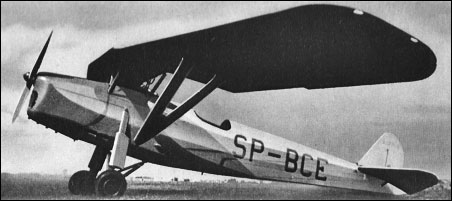Most extensively built of all R.W.D. designs, the two-seat parasol-wing R.W.D.8 was first flown in prototype-form in late 1932. Its design incorporated a braced monoplane wing which had 12° of sweepback on its outer panels, fixed tailskid landing gear and open cockpits in tandem. Powerplant of the prototype was a 86kW Cirrus Hermes II, but the R.W.D.8 later appeared with a variety of engines in the 75/112kW range before production ended. Early testing showed that the aircraft had excellent performance, and about 100 were built by D.W.L from early 1934 to 1938. However, the R.W.D.8 was also selected for use as the standard primary trainer of the Polish air force, and with demands far exceeding the capability of the R.W.D. plant a manufacturing licence was granted to Podlaska Wytwornia Samolotow (P.W.S.). This company's aircraft differed slightly from the civil version, incorporating modifications requested by the Polish air force, and a total of about 500 was eventually built by P.W.S. Licences to build the R.W.D.8 were acquired also by Czechoslovakia, Estonia and Yugoslavia, but only the last country is known to have produced the type in some numbers.
In addition to full participation in sporting events during the mid- to late 1930s, the R.W.D.8 had a stirring finale to its military career in the days that followed the German invasion, even being used to harass enemy troops by dropping grenades upon them. About 60 aircraft escaped to Romania in the closing stage of the battle, many surviving the war, and others captured by German and Soviet forces also found employment in the training role.






